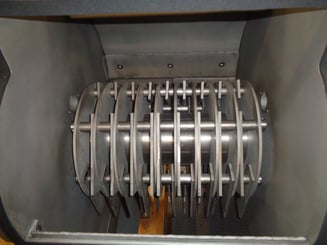Industrial hammer mills are employed in particle reduction applications for processing material. Though machine designs vary, the basic hammer mill working principle remains the same—uniform size reduction of aggregate raw material is achieved by repeated blows with hammers mounted to a rotating shaft. Whether coffee beans or titanium, hammer mills can effectively grind, shred, shatter, or pulverize any raw material to the desired outcome upon impact.
Basic Milling Technology and the Evolution of Hammer Mills
 Milling has been used for thousands of years to grind coarse material into a fine powder, most notably, think of grains like wheat or minerals like salt. With the advent of industrial milling over the past couple of centuries, the hammer mill evolved from a crude device used for crushing stone into a modern machine used for material processing by numerous industries.
Milling has been used for thousands of years to grind coarse material into a fine powder, most notably, think of grains like wheat or minerals like salt. With the advent of industrial milling over the past couple of centuries, the hammer mill evolved from a crude device used for crushing stone into a modern machine used for material processing by numerous industries.
Through its many design iterations, the fundamental aspects of hammer mills have remained the same. A varying number of hammers are supported between rigid plates assembled onto a rotating shaft. Mounted horizontally or vertically, the hammers swing freely around the shaft to crush aggregate material fed into the pulverizing chamber from above. It is then progressively crushed between the milling elements (mantle and concaves), finally exiting the pulverizing chamber at the bottom through the influence of gravity.
Inside the grinding housing, the raw material is reduced not only by the repeated blows of the hammer but by the walls of the grinding chamber and the impact of particle on particle. Specially designed metal screens or steel grates classify the material and discharges it once it’s been reduced to its desired size. Heavier and more free-flowing materials can easily exit the device through gravity. Lower density materials generally are discharged via pneumatic suction. No material is discharged from the mill until it can pass through the openings in the metal screen or steel grate. This ensures consistency and uniform particle size.
Other factors in the design variation of hammer mills include the size of the housing, the rotor, hammer size, screen or grate type, and rotational speed. For example, the higher RPMs of a rotor will increase the centrifugal force of the hammers, which magnifies the impact force of each blow upon the material. The RPMs and energy released through centrifugal force combine to achieve the desired particle reduction of the raw material fed into the housing.
Hammer Mill Capacity Requirements
Capacity requirements of any hammer mill application relate to the raw material being processed. The size and type of machine necessary to process the raw material weigh, literally and figuratively, on the properties and physical structure of the raw material. You would not need the same hammering machine to produce cake mix as you would process coal.
In today’s modern industrial hammer mill designs, high capacities and power efficiency are important requirements for any machine. However, achieving uniform particle size is essential for all industrial and food processing applications. The development of screen technology has enhanced uniformed end product quality and equipment productivity. In particular, Prater’s Full-Screen design system distributes raw material across the entire available screen area for even hammering and grinding, resulting in increased throughput capacity without increasing power requirements.
Customizing the Hammer Mill Design for Your Application
The simplicity of design allows for customization in processing a wide range of materials that serve many industries. Food, mineral, pulp and paper, chemical, agriculture industries all rely on hammer mills for processing their products. Hammer mills can effectively reduce raw material to desired sizes as needed, from medium-sized particles to ultra-fine-sized particles. Whether food pellets for livestock feed, granules of sugar, spices or minerals, powders for pharmaceuticals, chemicals, meal, or flour, hammer mills are vital to industrial production.
As the best known and widely used particle reduction device, the hammer mill provides solutions for the demanding processing challenges of raw material. Prater Industries meet these challenges with advanced technological applications, innovative design, and a thorough grasp of industry requirements and expertise to provide companies with state-of-the-art milling solutions and a guaranteed ROI on equipment.


